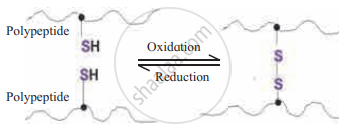Advertisements
Advertisements
प्रश्न
Long answer question.
Enlist the point of differences among DNA and RNA.
उत्तर
- DNA:
- It is the genetic material of the majority of the organisms.
- It is double-stranded.
- Deoxyribose sugar is present.
- Nitrogen bases like Adenine, Guanine, Cytosine, Thymine are present.
- Specific base pairing is observed.
- Total number of purines is equal to the total number of pyrimidine. Thus, the purine to pyrimidine ratio is 1:1.
- It is present in the nucleus.
- It is responsible for determining hereditary characters and for formation of RNA.
- RNA:
- It is a genetic material only of some viruses.
- It is single-stranded.
- Ribose sugar is present.
- Nitrogen bases like Adenine, Guanine, Cytosine, Uracil are present.
- Nitrogen bases do not form pairs.
- The amount of purine and pyrimidine may or may not be equal.
- It is present in the nucleus and cytoplasm.
- It takes part in protein synthesis.
APPEARS IN
संबंधित प्रश्न
Answer the following question.
How many types of polysaccharides you know?
Answer the following question.
Enlist the significance of carbohydrates.
Answer the following question.
Explain the induced fit model for the mode of enzyme action.
Answer the following with reference to the following figure.

- Name the type of bond formed between two polypeptides.
- Which amino acid is involved in the formation of such bond?
- Amongst I, II, III and IV structural level of protein, which level of structure includes such bond?
Match the following items given in column I and II.
| Column I | Column II | ||
| i. | RNA | a. | Induced fit model |
| ii. | Yam plant | b. | Flax seeds |
| iii. | Koshland | c. | Hydrolase |
| iv. | Omega-3-fatty acid | d. | Uracil |
| v. | Sucrase | e. | Anti-fertility pills |
Long answer question.
Explain the chemical nature, structure and role of phospholipids in the biological membrane.
Long answer question.
Describe classes of proteins with their importance.
Long answer question.
Describe the factors affecting enzyme action.
If double-stranded DNA has 14% C (cytosine) what percent A (adenine), T (thymine) and G (gaunine) would you expect?
Name the form in which carbohydrate is transported in a plant.
